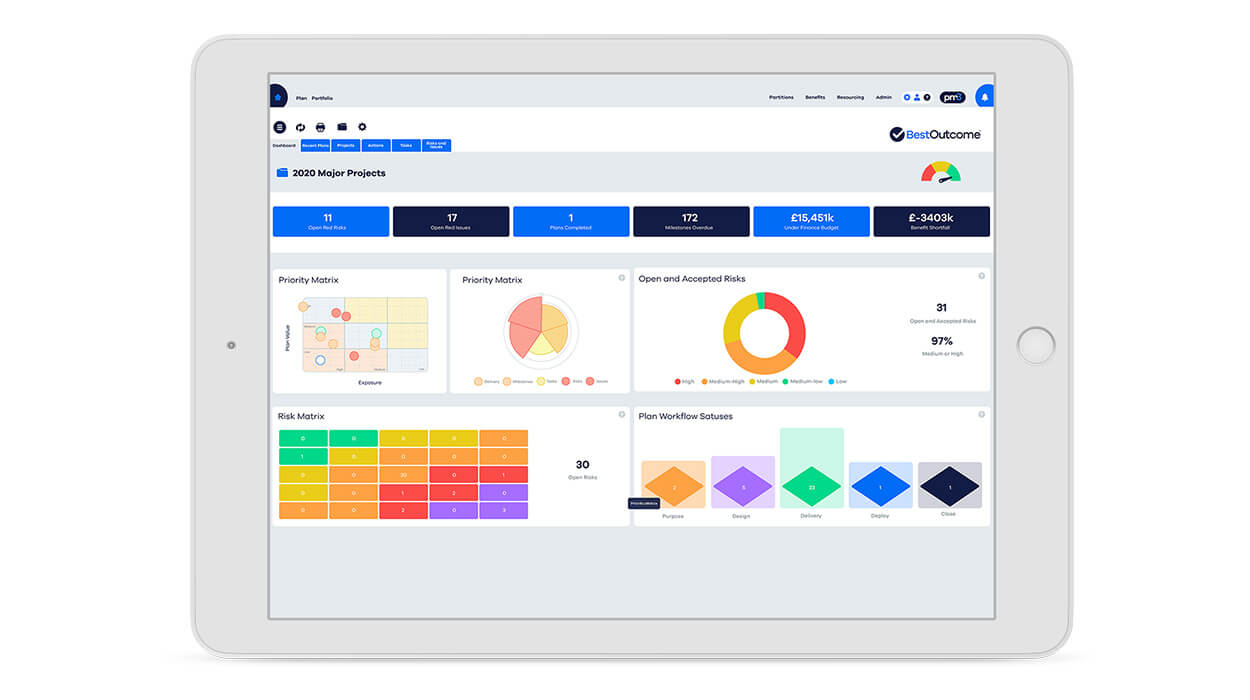In the world of performance management and goal-setting, two acronyms frequently come up: OKR vs KPI.
While they might seem similar at first glance, OKRs (Objectives and Key Results) and KPIs (Key Performance Indicators) serve distinct purposes and have different methodologies.
Understanding the differences between OKRs and KPIs is crucial for organizations looking to effectively measure and improve their performance.
Whether you’re a team leader, a product manager, or a simply a professional looking to optimize your personal performance, the insights provided in this comprehensive guide will serve as your compass in the complex realm of goal-setting and performance measurement.
Table of contents:
Let’s get started!

Objectives and Key Results, commonly referred to as OKRs, are a goal-setting and performance management framework that has gained significant popularity in the business world.
Originally conceived by Andy Grove at Intel, OKRs were later popularized by companies like Google.
This approach has since been adopted by organizations of all sizes, from startups to Fortune 500 companies, due to its effectiveness in driving focus, alignment, and measurable results.
Objectives
Objectives in OKRs represent the aspirational and qualitative goals that an organization, department, or team aims to achieve.
These objectives serve as the North Star, guiding everyone towards a common purpose.
Besides being attainable, objectives should be inspiring, motivating, and provide a clear sense of direction. In essence, they answer the question of “what” needs to be accomplished.
Key Results (KRs)
Complementing the objectives, Key Results (KRs) are specific, measurable, and time-bound milestones or metrics that indicate progress towards achieving the stated objectives.
They help you measure success by answering the question of “how” exactly progress will be tracked and evaluated.
KRs are designed to be concrete and actionable, making it evident whether the desired outcome has been accomplished.
Why OKRs matter
The beauty of OKRs lies in their simplicity and flexibility: they are typically set for a defined period, often quarterly or annually, and are meant to be reviewed and revised as necessary.
The adaptability of these goal-setting frameworks allows organizations to pivot and adjust their goals in response to changing circumstances, market dynamics, or strategic shifts.
OKRs also encourage transparency and alignment within organizations.
When each team and individual has a clear set of objectives and KRs, it becomes easier to see how their efforts contribute to the overarching goals of the company, hence encouraging a sense of purpose and helping teams prioritize their work effectively.
Key Performance Indicators, often abbreviated as KPIs, are a fundamental component of performance measurement and management within organizations.
Unlike Objectives and Key Results (OKRs), which are primarily focused on setting goals and tracking progress toward those goals, KPIs serve a different but equally crucial role in assessing performance and guiding decision-making.
Quantifiable metrics
KPIs are, by definition, quantitative metrics.
They provide organizations with a way to measure performance objectively, often using numerical values or percentages.
These metrics are chosen strategically to reflect critical aspects of an organization’s performance.
Performance evaluation
While OKRs are used to set goals and objectives, KPIs are used to evaluate and assess performance against those goals.
KPIs are tied directly to an organization’s strategic objectives and are used to determine whether those objectives are being met.
In essence, they help answer the question: “How well are we performing?”
Specific to different domains
KPIs can vary widely across industries and functions within an organization.
For example, sales teams may use KPIs like monthly revenue, conversion rates, and customer acquisition cost, while customer support teams may track KPIs like response time and customer satisfaction scores.
Each department or team may have its own set of KPIs tailored to its specific goals and responsibilities.
Long-term measurement
KPIs are typically used for long-term performance assessment.
They are often tracked continuously or periodically, such as monthly or quarterly, to monitor progress and trends over time.
The historical data gathered from KPI check-ins can provide valuable insights into performance patterns and areas that require improvement.
Strategic decision-making
KPIs play a vital role in guiding strategic decision-making.
When organizations track KPIs consistently, they can identify areas of strength and weakness and adjust their strategies accordingly.
For instance, if a KPI related to customer satisfaction shows a declining trend, it can works as a baseline for changes in customer service processes or strategies.
Alignment with organizational goals
KPIs should always align with an organization’s overall goals and objectives.
They serve as a direct link between strategic intentions and performance outcomes.
When KPIs are well-defined and aligned, they provide a clear path for organizations to monitor progress toward achieving their mission and vision.

To gain a deeper understanding of how Objectives and Key Results (OKRs) work in practice, let’s explore some concrete examples across various business contexts.
These examples will illustrate how organizations use OKRs to set ambitious objectives and measure the progress of their initiatives through key results.
Example 1: Company-wide OKRs
Objective: Achieve Sustainable Growth in the Next Year
Key results:
In this scenario, the company’s objective is to achieve sustainable growth. The key results provide specific, measurable targets that indicate whether the company is making progress towards this overarching goal.
Example 2: Departmental OKRs (marketing team)
Objective: Enhance Brand Visibility and Engagement
Key results:
Here, the marketing department has set objectives related to enhancing brand visibility and engagement. The key results are designed to measure various aspects of their performance, such as web traffic, social media growth, and email marketing effectiveness.
Example 3: Team-level OKRs (product development)
Objective: Deliver a High-Quality Software Release
Key results:
In this case, the product development team’s objective is to deliver a high-quality software release. The key results focus on specific aspects of software development, such as code quality, bug reduction, and meeting project timelines.
Example 4: Individual OKRs (sales representative)
Objective: Exceed Sales Targets for the Quarter
Key results:
Here, an individual sales representative has set their objective to exceed quarterly sales targets. The key results specify quantitative targets related to revenue, client acquisition, and upselling.
These examples highlight how OKRs can be customized to suit different levels of an organization, from company-wide objectives to departmental, team-level, and even individual goals.
OKRs provide a clear structure for setting objectives and measuring progress, promoting alignment and transparency throughout the organization. They empower individual teams to work collaboratively toward achieving ambitious yet attainable goals.
To gain a comprehensive understanding of Key Performance Indicators (KPIs) and how they function in various business domains, let’s explore practical examples across different areas.
These examples illustrate how KPIs are used to measure and evaluate performance effectively.
Sales KPIs:
Employee performance KPIs:
Marketing KPIs:
These examples demonstrate the versatility of KPIs across different business functions.
KPIs are selected based on an organization’s specific goals and objectives, providing a quantitative framework to assess performance, make data-driven decisions, and continuously improve processes.
Whether it’s in sales, HR, marketing, or any other area, KPIs play a pivotal role in measuring success and driving strategic decisions.
OKRs vs KPIs: Which one should I use?
Deciding between Objectives and Key Results (OKRs) and Key Performance Indicators (KPIs) is a critical choice for organizations seeking to manage and measure their performance effectively.
Each framework has its distinct characteristics and applications, and understanding their differences is essential for aligning them with your organization’s goals and needs.
When to use OKRs:
When to use KPIs:

The choice between OKRs and KPIs should align with your organization’s specific needs and goals:
Using both OKRs and KPIs together:
In many cases, organizations choose to use both OKRs and KPIs in tandem.
OKRs set the big-picture intentions and aspirational objectives, while KPIs provide the day-to-day metrics needed to monitor performance within teams and departments.
This combination allows for a comprehensive approach to performance management, encompassing both high-level goals and specific, quantifiable measurements.
Ultimately, the choice between OKRs and KPIs, or the decision to use both, should be guided by your organization’s performance management strategy and its specific objectives.
By leveraging the strengths of a KPI or OKR framework, organizations can optimize their approach to achieving both aspirational objectives and measurable results.

When it comes to effectively implementing performance management frameworks like Objectives and Key Results (OKRs) and Key Performance Indicators (KPIs), having the right software tools at your disposal can make all the difference.
These tools streamline the process, making goal-setting, tracking, and measurement more efficient.
One notable solution in the project management software landscape is PM3.
PM3 stands out as an award-winning PPM (Portfolio, Program, and Project Management) tool designed with a clear focus on delivering results. It is tailored to organizations of various sizes, whether they are running a few projects, large transformation programs, or managing complex portfolios.
Key features of PM3:
While exploring software solutions for implementing OKRs and KPIs, both private businesses and public organizations often find PM3 to be a valuable ally.
Its comprehensive features and user-friendly interface align well with the principles of goal setting and performance measurement, making it a solid choice for organizations seeking clarity and success in their projects.
For more info about how PM3 can help your organization set OKRs and KPIS, schedule a demo now or contact us at pm3sales.us@elecosoft.com

Our products help you deliver successful change programmes and projects by always focusing on the overall business outcomes. Find out how our products can help you.